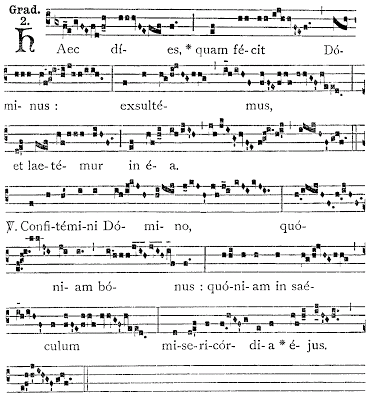Gregorian Chant
The Gregorian chant is one of the earliest known examples of Western music. These chants were performed during the services of the Roman Catholic Church, and their lyrics were always based on sacred Latin texts. The Gregorian chant is completely different from music as we know it today: it is monophonic (everyone sings the exact same melody in unison), and there is no rhythm; the performers followed the natural inflections of the text, rather than keeping to a specific beat or rhythm.
History
The Gregorian chant originated from the Roman Catholic Church, where it served as functional music during their worship services (this, in turn, evolved from the Hebrew chant tradition). Initially these chants were passed down orally and were not recorded, until the papacy of Pope Gregory I, after whom the Gregorian chant is named.
From 590 - 604 C.E., the Roman Catholic Church was lead by Pope Gregory I. Pope Gregory notated, organised, and codified the many chants used during church services. He also expanded musical schools, in order to train singers in the performance of sacred music. These actions were instrumental in the development of Western music.

Pope Gregory I (left), the namesake of the Gregorian Chant. On the right, the painting depicts a scribe who is recording a Gregorian chant.
Haec Dies
Haec dies is an example of a Gregorian chant, written in the early Middle Ages by an unknown composer. It was performed every year as part of the Easter Sunday mass. You can listen to a recording of Haec dies below:

A transcript of Haec dies, written in the musical notation of the Middle Ages.
In the recording, the entire piece is sung by a choir throughout. During the Middle Ages, some passages would actually be sung by a soloist, in order to highlight the importance of those parts of the text. If you listen closely, you'll also notice that each syllable of the text is spread across many notes; this is known as melismatic singing. In Haec dies, melismatic singing helps to convey the joyful mood of Easter.
Ut Queant Laxis
If you've watched "The Sound of Music", you'll know the seven notes which are used as the basis for most music: do, re, mi, fa, sol, la, and ti. This naming system is known as the solfège system. At first, the note names used in the solfège system may sound strange, as though they were arbitrarily chosen. But the names of these
notes originate, in fact, from the text of a Gregorian chant: Ut queant laxis. In the 11th century, a monk named Guido of Arezzo (ca. 991 - 1033) attempted to create a new method for teaching singers. He took the text of Ut queant laxis, and used the first syllable of each phrase as the name of a specific note. Below are the lyrics of Ut queant laxis, with the syllables used by Guido in bold:
Ut queant laxis
Resonare fibris,
Mira gestorum
Famuli tuorum,
Solve polluti
Labii reatum,
Sancte Joannes.
Guido's system now had the notes: ut, re, mi, fa, so, and la. This eventually evolved into the modern solfège system, as we know it today. Below, you can listen to a recording of Ut queant laxis:

A transcript of Ut queant laxis, written in the musical notation of the Middle Ages.


